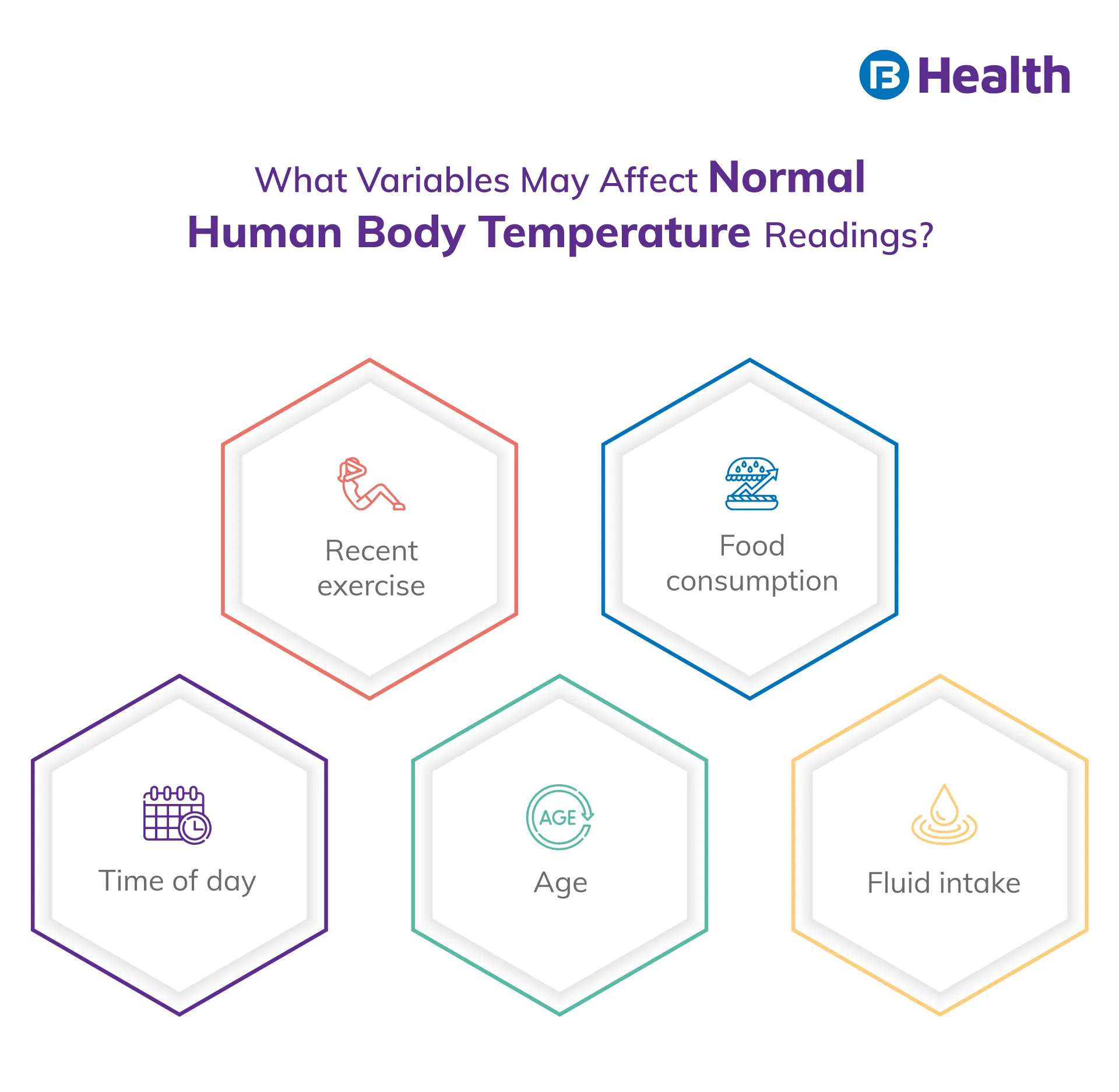General Health | 8 min read
Normal Human Body Temperature Range: Adults and Children
Medically reviewed by
Table of Content
Synopsis
You don't need to frequently check your normal human body temperature if you are healthy. However, you should check it more regularly if you feel ill or believe you may have come into touch with a disease like COVID-19. The normal human body temperature of an individual varies based on a variety of variables, including age and degree of activity.
Key Takeaways
- Normal Human Body Temperature was thought to be 98.6 degrees Fahrenheit
- The average individual today runs somewhat colder than that, between 97.5 F (36.4 C) and 97.9 F. (36.6 C)
- A temperature of 100.9°F (38.3°C) or above is considered a fever
Body temperature varies from person to person and it depends on several factors like their age, gender, etc. An unusually high or low temperature sometimes indicates underlying medical conditions. So what is the normal human body temperature? Let’s explore.
What’s Normal Human Body Temperature?
98.6°F (37°C) is considered the normal human body temperature. Experts commonly agree that the normal temperature of the human body is 98.6°F (37°C). However, to be more precise, the ‘normal’ range for body temperature is between 97°F (36.1°C) and 99°F (37.2°C) [1].
Mostly, fever brought on by an infection or disease is indicated by a temperature exceeding 100.4°F (38°C). Changes in normal human body temperature occur throughout the day.
However, this figure is only an average. You might have a little higher or lower body temperature. Also, a higher or lower body temperature is not always indicative of any illness. Your age, gender, time of day, and amount of exercise are just a few things that might affect your body temperature.
Body Temperature
The body location from where a person conducts the measurements on their body affects the normal human body temperature results. For instance, rectal temperatures are greater than oral temperatures, although armpit temperatures are often lower.
The following variables may also affect normal human body temperature readings:
- Age
- Time of day, with peaks in the late afternoon and lowest in the early morning
- Recent exercise
- Food consumption and
- Fluid intake

Normal Human Body Temperatures by Age
The capacity of your body to control the temperature as you become older changes.
Generally speaking, adults over 64 have more difficulty responding to unexpected variations in temperature. In general, elderly folks have more trouble keeping their body warm. Furthermore, the normal human body temperature is more likely to be lower.
Knowing your usual range might help you recognise when you are feverish.
Normal Temperature in Adults
The Normal human body temperature for adults is as follows:
- Reviews indicate that the average adult body temperature measured across all sites is 97.86°F (36.59°C)
- It is also discovered that the typical adult body temperature measured orally ranges from 97.2 to 98.6°F (36.24 to 37°C)
- Every group has a different average body temperature. According to research by The BMJ, older people had the lowest average temperatures, while African American women had higher average temperatures than white males, according to almost 35,488 participants.
- In the same research by The BMJ, it was discovered that certain medical disorders could modify body temperature. People with cancer often had higher temperatures than those without cancer. On the other hand, those with hypothyroidism (an underactive thyroid) typically had lower temperatures [2].
The following temperatures often indicate that a normal human body temperature has a fever:
- At least 38°C, or 100.4°F a fever
- That exceeds 103.1 °F (39.5 °C) or a severe fever
- That exceeds 105.8°F (41°C) is an extremely high fever
Normal Body Temperature in Children
We can describe the normal body temperature for kids can be as follows:
Children's body temperatures vary, but the typical range is 97.52°F (36.4°C). Children may get a fever if their temperature rises beyond 100.4°F (38°C), just like adults.
Normal Body Temperature in Babies
Compared to older children and adults, infants often have greater body temperatures. For newborns, the normal body temperature is around 99.5°F (37.5°C).
A baby's body surface area is more than their body weight, which causes their temperature to be higher. Their bodies also produce heat due to their increased metabolic activity.
The bodies of infants do not control the temperature as well as those of adults. When it's hot, they perspire less, allowing their bodies to retain more heat. A fever may make it more challenging for them to cool off.
Additional Read: Newborn Cough and ColdThe following is a table that illustrates the average normal human body temperature based on age:
Age | Oral | Rectal/Ear | Armpit |
| 0-12 months | 95.8–99.3°F (36.7–37.3°C) | 96.8–100.3°F (37–37.9°C) | 94.8–98.3°F (36.4–37.3°C) |
| Children | 97.6-99.3°F (36.4-37.4°C) | 98.6–100.3°F (37–37.9°C) | 96.6–98.3°F (35.9–36.83°C) |
| Adults | 96–98°F (35.6–36.7°C) | 97–99°F (36.1–37.2°C) | 95–97°F (35–36.1°C) |
| Adults over 65 years of age | 93–98.6°F (33.9–37°C) | 94–99.6°F (34.4–37.6°C) | 92–97.6°F (33.3–36.4°C) |
How to Check Temperature
You may take your or a family member's temperature in four distinct methods mentioned below. The reading can change from one approach to the next.
Which approach experts suggest for each age group for the normal human body temperatures may be seen in the table below:
Age | Rectal | Temporal (forehead) | Oral | Tympanic(ear) |
| Under 3 months | Yes | |||
| In-between 6 months | Yes | Yes | Yes | |
| 6 months- 3 years | Yes | Yes | Yes | |
| 4 years-teens |
| Yes | Yes | Yes |
| Adults | Yes | Yes | Yes | |
| Over Adults | Yes | Yes | Yes |
Suppose someone took your temperature under the armpit or beneath your arm. This approach is not advised since it is less precise.
Thermometers come in a variety of styles to check the temperature. They are listed as follows:
Digital Thermometers
Digital thermometers are widely available and provide accurate temperature readings. A person can use them on numerous parts of their body to check their normal human body temperature.
- Rectal measurement: A specialized digital thermometer is a popular choice for taking a child's temperature in the rectal area. Before placing these devices into the anus, one should clean and lubricate the end of the instrument. When the gadget has taken reading and is secure to remove, it will notify the user.
- Oral Measurement: Standard digital thermometers are easy to use orally for oral measurement (by mouth). Before using, the individual must clean the device’s tip. The patient will next seal their lips and place this beneath their tongue in the back of their mouth. The device will display the reading on the device's built-in display.
- Armpit Measurement: A digital thermometer can be placed above someone's armpit to measure the axilla (armpit). The arm must stay tightly against the body to obtain a satisfactory reading.
Infrared Thermometers
Temperature measurements may be made at a distance using infrared thermometers. These, however, are not as precise as other approaches.
Tympanic thermometers can collect readings from the ear canal. To check them for measuring the normal human body temperature, one will:
- Place the device's tip in their ear
- Match it to their ear canal
- Activate the gadget till a result is obtained
Temporal thermometers monitor a person's temperature via an infrared signal. Usually, the thermometer is held a few millimeters from the subject's forehead while the user waits for the instrument to give a reading.
According to one research by the National Library of Medicine, while forehead and ear measures are valid, nontraumatic screening choices for neonates are not as reliable as rectal measurements.
What Factors can Affect Your Temperature?
In the nineteenth century, German doctor Carl Wunderlich discovered that the average normal human body temperature was 98.6°F (37°C) [3]. However, several investigations have shown that this isn't always the case.
According to a 2019 Oxford Academic study, the average normal human body temperature is 97.86°F (36.59°C). That's a touch lower than was first estimated so many years ago.
However, because no one statistic describes your normal body temperature, it's advisable to take this information with a grain of salt. Instead, consider a temperature range greater or lower than the average.
Some of the elements that influence body temperature are as follows:
- Our bodies heat up during the day
- Because our capacity to control body temperature declines with aging, older people have lower body temperatures
- Body temperatures are greater in younger people
- Temperature is affected by a physical activity because the more you move your body, the warmer your core becomes
- Hotter and colder weather can also reflect your body temperature, which rises in hot weather and falls in cold weather
- Temperatures taken from the armpit are lower than those taken from the mouth
- Thermometer readings given through the mouth are lower than those taken through the ear or rectum
- Body temperature can be affected by hormone levels
- Excess weight due to body fat is also linked to increased body temperatures
- Body temperature is less in taller individuals
Body temperature can vary according to each individual, depending on their physiology. Check out the height-weight chart to notice any health conditions that may be overlooked. Also, the height-weight chart for children will be different.
Additional Read: How to Accurately Measure Your Height at HomeWhat Temperature Do You Get a Fever?
A higher-than-normal thermometer reading indicates a fever. A temperature of 100.9°F (38.3°C) or above is considered a fever. As previously stated, the precise reading depends upon several factors. You may develop a fever if your temperature rises over the typical range outlined earlier in this text.
A temperature that is 2°F (1.1°C) or higher than the normal human body temperature is typically indicative of a fever.
Symptoms of Fever
Other signs and symptoms that may accompany fever include:
- Sweating or sensation flushed
- Chills
- Pains and aches
- Headache
- A loss of appetite
- Weakness or lack of energy due to dehydration
Our bodies have a built-in temperature regulation mechanism. This procedure boosts the normal human body temperature in reaction to sickness and infection, which the human body may occasionally fight on its own. Without therapy, the human body temperature will most likely return to normal with time and relaxation.
Call a general physician if your temperature is 103 degrees Fahrenheit or higher. Also, call a physician if you've had a fever for more than three days. If you have fever and symptoms such as severe throat swelling, vomiting, headache, chest discomfort, stiff neck, or rash, then get a doctor consultation.
Bajaj Finserv Health provides personalized healthcare services for you and your family. Visit Bajaj Finserv Health to find the best physicians in your area, make appointments, set reminders to take your medications, save all your medical information in one location, and more.
References
- https://medlineplus.gov/ency/article/001982.htm
- https://www.everydayhealth.com/thyroid-conditions/hypothyroidism/internal-temperature/
- https://dearpandemic.org/normal-body-temperature/
Disclaimer
Please note that this article is solely meant for informational purposes and Bajaj Finserv Health Limited (“BFHL”) does not shoulder any responsibility of the views/advice/information expressed/given by the writer/reviewer/originator. This article should not be considered as a substitute for any medical advice, diagnosis or treatment. Always consult with your trusted physician/qualified healthcare professional to evaluate your medical condition. The above article has been reviewed by a qualified doctor and BFHL is not responsible for any damages for any information or services provided by any third party.



